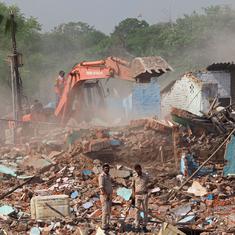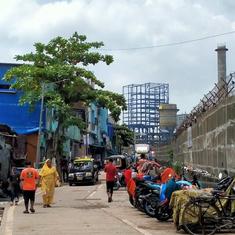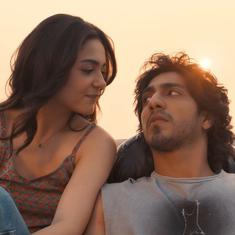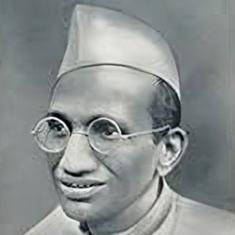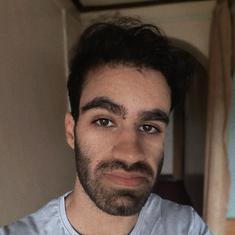Among the black and white photographs my parents left behind there is one of a little girl being carried by a portly woman, looking at a vast expanse of water. The little girl was me in the lap of my parents' Bengali friends at the Bhakra Nangal Dam in 1957, six years before Prime Minister Jawaharlal Nehru officially inaugurated the first Temple of Modern India. My parents and their friends were so excited by the idea of the dam that they had gone to see it for themselves and marvel at the idea that it would soon irrigate thousands of acres of land and help alleviate the sufferings of poor farmers.
They stayed at a rather luxurious guest house called Satluj Sadan for two or three days just gazing at the dam: it was as if they were looking at a dream becoming a reality before their eyes.
My parents made me aware of the enormous diversity of cultures, by driving from Delhi to Kanyakumari two years later. I was brought up to believe that all Indians were a part of this massive family. Ever so often, my father sang Iqbal’s Saare Jehan se Accha Hindustan Hamara. He had no idea that Iqbal had already disowned the song five years after he wrote it. He had re-written it with the following opening words:
Chin o Arab hamaraa hindostaan hamaara
Muslim hain hum; watan hai saara jahaan hamaara
tawheed ki amaanat seenon mein hai hamaarey
aasaan naheen mitaana naam o nishaan hamaara
Central Asia [In Iqbal’s time, Chin referred to Central Asia] is ours, Arabia is ours, India is ours
We are Muslims and the whole world is our homeland
The treasure of tawhid is in our hearts,
It is not easy to wipe out our name and mark.
Iqbal’s change of words reflected his disillusion with the direction India seemed to be heading. My parents had witnessed the horrific events that led to the Partition and their reaction was not to allow their children to know that people could be divided into Hindus and Muslims. This was their way of contributing to the idea of an India that would be democratic and secular.
But I discovered that this solution may reflect an idealism but not wisdom. I realised that by not talking of differences, we did not acknowledge the very real discrimination, humiliation and oppression Indian Muslims feel on a daily basis.
Dreaming of Utopia
I was born in an era when the future was looked upon as a place of hope, progress, even a Utopia. I was brought up with the idea that if we only worked hard enough with commitment and devotion we could build a truly beautiful country.
The first shock came in the 1970s when I came in touch with the Naxalites. From them, I learnt the fact that hundreds and thousands of people had been displaced by the huge development projects, especially dams. At first I thought perhaps it was a price we as a country had to pay to progress but the facts and figures hit me like a tight slap across my face. And soon it was not only the Naxalites who were talking about these displacements. The people resisted in every corner of the country but the media reached only a few villages. The best publicised the movement is of course the one led by Medha Patkar against the Sardar Sarovar Dam.
The government recognised that dam building is one of the most important causes for development related displacement. According to a report presented in 2013 to the Lok Sabha: “During the last 50 years, some 3,300 big dams have been constructed in India. Many of them have led to large-scale forced eviction of vulnerable groups. The situation of the tribal people is of special concern as they constitute 40%-50%of the displaced population.
According to a study conducted by Nalin Negi and Sujata Ganguly for the University of Bielefeld, Germany (2011), around 50 million people have been displaced in India due to development projects in over 50 years. Of these, dams, mines, industrial development and others account for over 21 million development-induced internally displaced people.
Fifty million is just a statistic. In fact, the figure means 50 million individual tragedies: 50 million men, women and children deprived of their homes by development projects. What kind of development was this?
Legal battles
I decided to be a lawyer and take up cases on behalf the poor. In 1983, I was a junior lawyer and went to Bombay (as it was then) to help Indira Jaising who was fighting a case on behalf the pavement dwellers.
Jaising , who later became the first woman Soliciter General of India, had argued that if the pavement dwellers were not allowed to live on the pavements, they would have to pay for rent, and travel from far in which case they would have to spend their earnings on rent and travel leaving them very little money for food; they would not be able to buy 1,200 calories of food that was necessary and it would push them below the poverty line.
The Bombay Municipality argued that the people were obstructions and had to be evicted. I expressed my doubts about the judiciary’s ability to deliver justice. I still have a typed letter written to me on May 11, 1983, from Indira Jaising assuring me that the pavement dwellers would get justice.
She wrote to me:
“In any case, as I have always told you, I am confident that the judgement is going to come out in the best interests of the pavement dwellers. There is no way in which they can lose this case. This is my firm belief. It is one of those crucial cases on the outcome of which the credibility of the entire legal system in this country depends. If the legal system is not able to deliver results to the pavement dwellers, it will once and for all have to be abandoned as a system which does not work.”
Such was Indira Jaising’s faith in India’s judicial system. Two year later, the Supreme Court gave its judgment in favour of the Bombay Municipality. More recently, the courts have shown great leniency with rich people who run over and kill pavement dwellers while returning drunk from night parties. At least one Bollywood actress said the poor should not be sleeping on the pavements.
I realised that the Indian state was not waging a war against poverty but against the poor. It was a realisation that had struck many people across the country. The economists had obscene debates over how to define poverty but which ever way you counted the number of poor anyone could see that their numbers was rising. There are at least 259.5 million people people who are officially defined as “extremely poor”.
I had watched the All India Institute of Medical Sciences come up and had seen how poor and rich could access health care. But after India launched its new economic policy, the health services became more and more inaccessible. A friend once phoned to ask whether I knew anyone in AIIMS because a man needed to have his leg amputated and had been lying in the corridor of AIIMS for more than a month.
What sort of freedom is this?
An overwhelming number of Indian citizens have no social security. At least one songwriter, Nida Fazli, asked: “Yeh Kaisi Azadi Hai.” Jagjit Singh sang the song and Pravin Mishra directed a video with the song.
Here's a rough translation:
What sort of freedom is this?
Apart from a few homes, the people are starving, without clothes
The nation belongs to me as much as it belongs to you
Dalits, women, tribal, all together have built the nation.
By 1983 I had started practicing as a human rights lawyer in the Supreme Court. I had filed the first cases against the Armed Forces (Special Powers Act, 1958. I suddenly became aware that a large number of Indian citizens were living under army rule in democratic India. It was so shocking to learn that Indian armed forces had burnt down Naga villages and along with them human beings. I could not believe that Indian armed forces had actually bombed Aizawl in the 1960s and that in 1987 the armed forces committed such human rights violations that it compares with the tortures committed under army rule in Latin America.
The media would seldom carry the stories and they did not bother to follow up a case in which we had presented 10,000 pages of evidence of the atrocities committed by the Assam Rifles in Senapati district of Manipur. I finished arguing the case in 1991. But the Guwahati High Court has still not given its judgement.
That is why when Irom Sharmila began her hunger strike in 2000, we hoped the movement in Manipur against the vicious act would build up momentum. It could bring the Nagas, Meiteis and Kukis together around their common sense of injustice. However, the activists around her quickly appropriated her sacrifice; made her a symbol of Meitei nationalism. They made her a goddess. The Indian media, writers and journalists, celebrated her as a symbol of non-violent protest which they upheld as superior form of protest to armed resistance offered by many groups in the North East. They, the Indians saw Sharmila without the context of Manipur’s history and seemed oblivious to the fact that talking about her protest without mentioning the sufferings of other communities in Manipur would only add to the divisions within Manipur.
The media and activists in Delhi do not understand the anger against her now that she has decided to end her strike. The Meiteis are angry because she did not consult her family and supporters, but they are even more angry that she has announced that she is marrying a mayang or the derogatory word for outsiders. It has not helped that her boyfriend has not given any statement that shows he is as committed to her cause as he is to her.
But Irom Sharmila’s statement that she will stand for elections and she wants to be chief minister so she can repeal the Act reflects the bankruptcy of politics.
The media, gleefully say now she will take to politics and stand as an independent candidate. This assumes her fast was not a political act. It is also a testimony to the bankruptcy of political imagination that Irom Sharmila thinks that electoral politics can help her achieve her goal of the repeal of the Act. Strictly speaking, even if she became a chief minister and wanted to repeal the Act she could not because the Act is a central Act and can be repealed only by the parliament. Section 3 of the Armed Forces (Special Powers) Act allows the Centre to declare an area disturbed and send the armed forces without the permission of the elected government.
The Indian government's response to the North East has alienated more and more people. In 1950s, there was just one armed group in the region. There are around 23 armed groups in Manipur alone. The more groups there are the less possibility there is of conflict resolution through political process. I have had a ringside view of the Indo-Naga peace process and I know that neither side has a vision for the future.
In the Valley
It is not only the peoples of the North East that are alienated. The Kashmiris have been on the streets ever since the Indian armed forces shot Burham Wani, commander of the Hibzul Mujahideen on July 8. The Indian media is not able to explain why a man they call a terrorist is so beloved of his people. Why did so many hundreds of thousands of Kashmiris come out on the streets despite the deaths and injuries of so many in the firings and injuries by pellet guns?
Shujat Bukhari, a respected Kashmiri journalist, said it was a completely alienated generation. What do the Kashmiris want? Afzal Guru, who was executed for his role in the 2001 Parliament attack, wrote in a letter to me many years ago: “Economic packages can not bring peace in Kashmir. The people who are constantly living in the flux of humiliation and fear does not need bread for which Allah has given every person two hands for single mouth. What people need is a political framework in which they do not feel themselves vulnerable, humiliated or terrorized. The people of Kashmir want an honourable space to live on this planet. They are not demanding stars.”
Afzal Guru said he was not against my patriotism but he was against Modi’s nationalism. I believe the kind of nationalism we are seeing now will only alienate more people and divide us against each other. Political parties have not shown themselves capable of taking on the challenge of putting forward a viable vision for the future of our country.
I refuse to give India and Indian nationalism over to the Hindutva forces. My India, the India I dream about even now is an inclusive one, democratic country where all these complex questions are constantly debated and discussed. I too believe in Dalit scholar Rohith Vemula when he wrote: “Today, saffron blankets are spread over our conscience and we are doomed to believe that light is impossible. But the truth will come out like a shining RED sun in the BLUE sky and on that moment, the Saffron darkness will have to die.”
But I believe there will not be a day it will suddenly come. We have to work towards it, with the same commitment and faith as the freedom fighters did and we should remember even that struggle that we celebrate today ended with a bloody partition. Let us remember to guard against such an eventuality and fight for the azadi that student leader Kanhaiya Kumar talks about and inspired the country.
Yes, I am celebrating August 15 because it was a milestone in our struggle to achieve freedom. But it is also a day to remember the terrible mistakes we have made and to pledge to go forward towards a time when all citizens of India can equally feel they belong to this country. A new political vision, innovative strategies and imagination is needed for the new challenges before us.
Nandita Haksar is a human rights lawyer, teacher, activist and writer.

